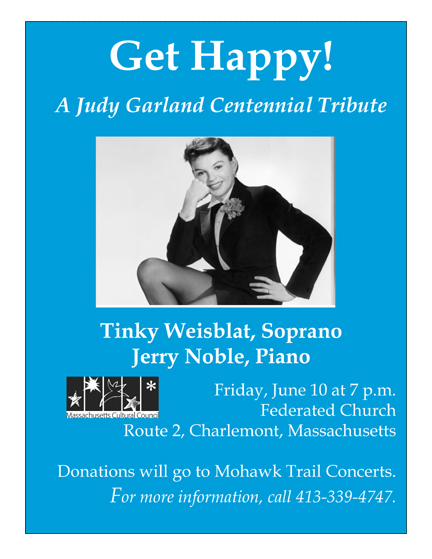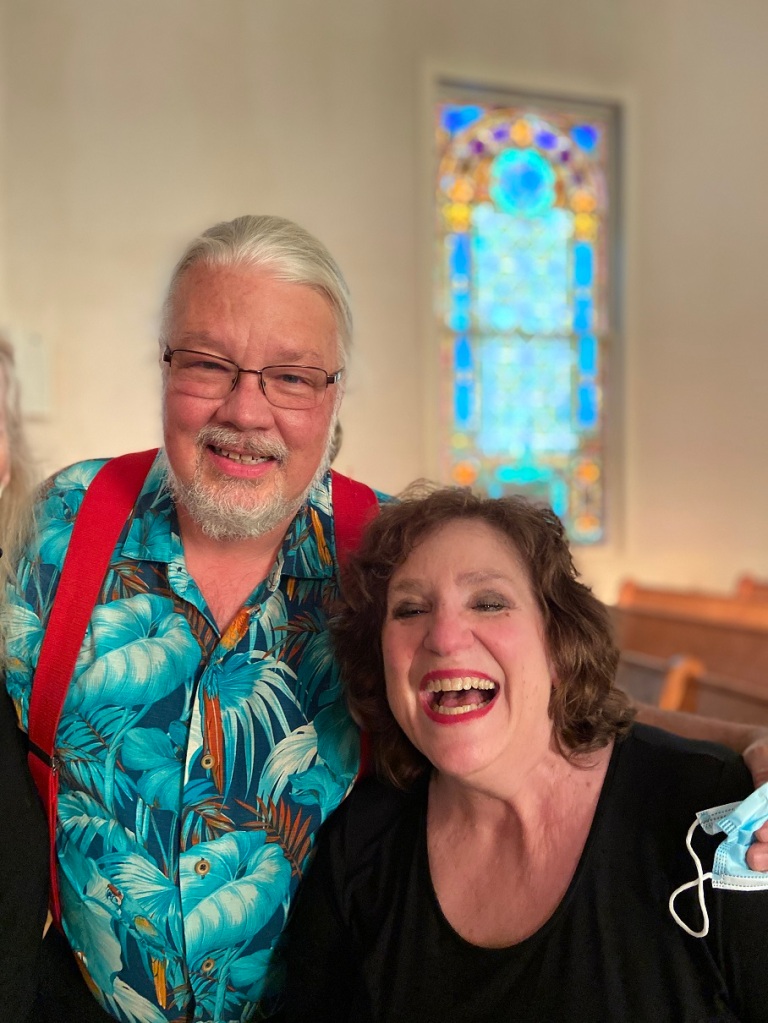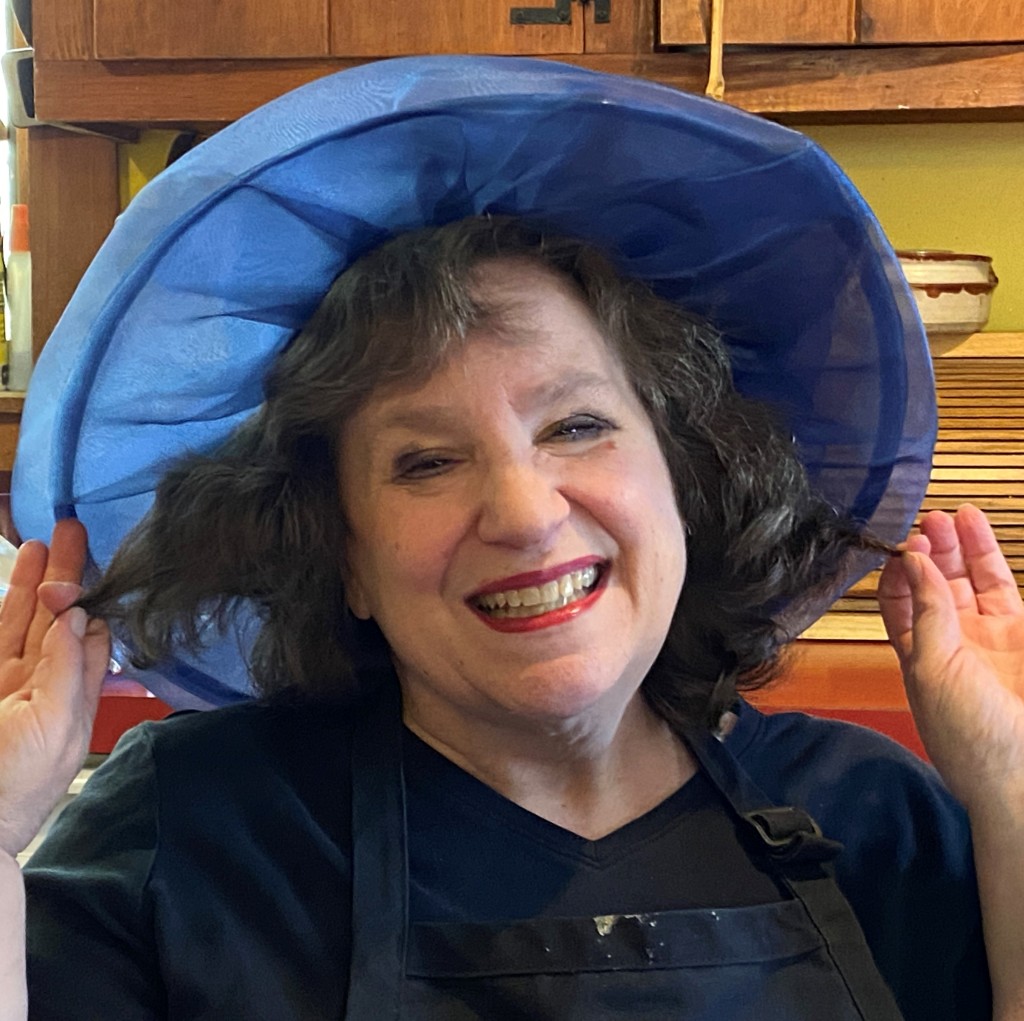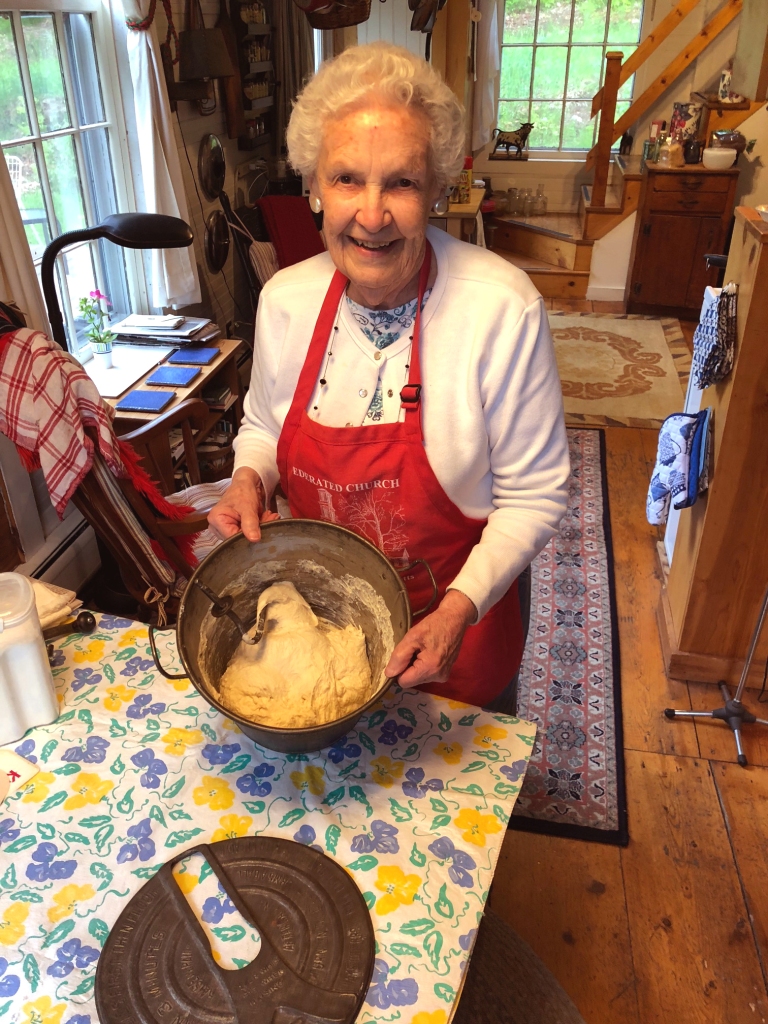
Happy new year! I know many local friends and readers have read my memorial article about my neighbor, Alice Parker Pyle. I post it below for those who haven’t yet seen it. I also refer you to my commentary about Alice (a bit more personal than the article) that aired on our local public-radio station, “The Gospel According to Alice.” That may be found at https://www.nepm.org/2024-01-02/the-gospel-according-to-alice-parker. On to Alice….
“We Must Sing Because Birds Do”: Remembering Alice Parker
Composer Alice Parker Pyle, known professionally as Alice Parker, devoted her life to singing and song. Parker, who died at her home in Hawley, Massachusetts, early on Christmas Eve, was 98.
Just about anyone who has ever sung in a choir or a chorus is familiar with Parker’s music. She composed, conducted, taught, and loved her family and community.
The Hawley resident composed more than 500 pieces. Her work included operas, song cycles, cantatas, and anthems. She was particularly known for the spirituals, hymns, and folk songs she arranged over the years, beginning during her longtime association with conductor Robert Shaw.
Parker spent summers in Hawley as a child at the appropriately named Singing Brook Farm.
“My father bought land in Hawley before I was born,” she said in a recent interview. “I think I was four months old the first time I came here, and it has always felt like home to me.”
With her siblings she swam, ambled up and down the brook as far as she could, and developed a lifelong affinity for the hills around her.
Along the way, she sang and made up tunes. “It was pretty clear from the time I was eight or so that I was going to be a composer,” she recalled.
Parker graduated from Smith College and went on to the Juilliard School in New York. There she studied music and conducting with choral impresario Robert Shaw and became his collaborator, arranging music for the Robert Shaw Chorale.
She worked with Shaw for 20 years. Their joint composition balanced much of the musical education she had received. The academy had emphasized originality and dissonance. Her time with Shaw, and her own heart, taught her the importance of melody and tradition … and the importance of being attuned to the human voice.
She maintained that the focus of her teaching was “to get people to listen to the music in the air, not the music imprisoned on a page.”
Parker always knew she wanted a family. She married baritone Thomas Pyle, had five children, and did her best to balance work and home in their New York apartment.
She began baking large batches of wholesome bread to feed her family. Her loaves of bread were prized throughout her life by relatives and neighbors.
After 21 years of marriage, Tommy Pyle died suddenly. “He was gone when I was 50, and I was faced with crafting a career for myself in uncharted waters, and also supporting these five children as they grew,” she said.
When Parker turned 70, she decided to move full time to Hawley, to what she had always thought of as her “heart’s home.”
She had already begun restoring Hawley’s old town hall, the Town House, to use on her frequent visits to help care for her aging mother. In 1996, she sold her New York apartment, added a studio and a heated garage to the Town House, and threw herself into life in Hawley.
She became active in the town’s historical society, the Sons and Daughters of Hawley. Hawleyites still chuckle as they recall the day in 2016 when she dressed as “Alfred Parker” (see photo below) to enter a Sons and Daughters pie competition that was restricted to male contestants.
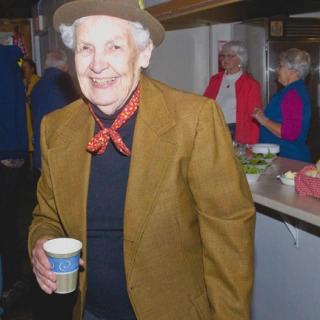
She also continued her involvement with Mohawk Trail Concerts, the chamber-music series she helped to found and attended every summer. She was a long-time board member, most recently with emerita status.
Mark Fraser, MTC’s executive artistic director, remembered Parker’s many matchless qualities, among them her institutional memory.
“When a question came up, even longtime board members would be scratching their heads, but Alice would come up with a nugget of how things had always worked and remind us of the history of Mohawk Trail Concerts,” he said.
He also celebrated her capacity to attract board members and donors just by being who she was. Above all, he recalled her wisdom, calling her “a clear thinker.”
When worries about the budget arose, as they frequently do in non-profit organizations, the treasurer would wonder aloud whether the concerts should slash their expenditures, Fraser noted. Parker always said of the money, “It’ll come.”
“And she was correct,” he concluded with a smile in his voice.
Parker loved to teach. In New York, she had often traveled to her students. In Hawley, they mostly came to her. Composers, conductors, and song leaders would arrive for a week of intensive study, staying at the family farmhouse up the road from Parker as her fellows.
The group members cooked for each other and for Parker, who maintained that good musicians are pretty much always good cooks. They gathered daily at the Town House to make music.
“It was planning our lives together,” she said of this experience. “It was music as a way of life.” Each fellowship week culminated in an event that gratified teacher, students, and neighbors as Parker and the fellows led a community SING.
Some of Parker’s fellows turned into lifelong friends. Alison Seaton, a music teacher and conductor in Washington State, returned every summer to spend time with the composer.
“Alice Parker was my teacher, mentor, and most importantly my friend for the last 15 years,” Seaton said in an email message. “She was a master teacher who asked that her students be willing to explore our craft in a new and elemental way—always through the lens of the text and melody first.
“’What is the song asking of you?’ she would ask us. She was generous. She shared her home, family, and oh so delicious family recipes. I am a transformed conductor for having studied with her, but, more importantly, I am a better human for having known her.”
As Parker aged and became more meditative, she come to see the three facets of her work—composing, teaching, and song leading—as the three equally crucial legs of the stool of her life.
In 1984 she founded Melodious Accord, a nonprofit organization that organized classes and symposia, published music, and celebrated the human voice. It also printed books that spread Parker’s philosophy of music.
The organization thrived on help from musicians and supporters who believed in Parker’s mission. Among these were Kay Holt and Marilyn Pryor of South Hadley, who volunteered to help her in any way they could.
“As two biologists who love to sing, our first meeting with Alice Parker filled us with awe as it did so many others,” the two wrote in a joint statement.
“Little did we know that in our retirement we would spend 23 years with her, travelling thousands of miles to hundreds of conferences, workshops, SINGS, and recording sessions in the U.S. and Canada.
“When home we assisted in any way that helped her best use her time composing, writing, and editing. We came to know her not just as a legendary figure in choral music, but for her tolerance and warmth for all people…. In sum, we became friends.”
Parker was a longtime member of the Federated Church in Charlemont. Mick Comstock, the church’s former minister (and a current member), remembered her contributions to the life and spirit of the church.
“For years at Christmas time, she led us in an evening of singing Christmas carols,” he said. “These were, of course, not her compositions but belonged to the world.
“The importance of these evenings was not what she did, but what she allowed to come forth from us. We were the singers, and our hearts were stirred as the songs resonated back through all our lifetimes to the very first time we heard them and sang them.
“This is an illustration of what she did for us every time she was with us. With us, she was not a composer or a performer. She was a fellow member with gifts that enriched us all, and became a lesson for us in how our own varied gifts enrich us all.”
In the last few years, macular degeneration began to restrict Parker’s ability to work, and she slowed down. Her mind never lost its sharpness, however, and she continued to cherish music, family, and community.
One of her last local public appearances was at the Ashfield FilmFest in September for a showing of Alice: At Home with Alice Parker. For the 2021 film, director Eduardo Montes-Bradley interviewed the composer about her work and life against the backdrop of a stark Hawley winter.
After Parker’s death, Montes-Bradley philosophized about what he had learned from her.
“With Alice, I learned to listen more and talk less, and that love is invisible,” he recalled. “Alice was the mother we all wish we had. In fact, I wouldn’t mind if my own was just a bit more like her. I know, Alice, I am doing it again. I am talking too much.
“And from Alice I also learned that we must sing because birds do.”
To me, an honorary niece, Alice Parker was a loving, laughing neighbor. She spent time by my mother’s deathbed to give me a break. She considered herself the chief taster for the recipes I developed for articles and cookbooks.
When I started to sing semi-professionally, she volunteered to accompany me. She was my partner in song until five years ago, when she could no longer read music.
She often asked me to sing for the composers and song leaders who came to study with her, not because my voice was exceptionally good—it wasn’t and it isn’t—but because I sang with heart and humor.
I think she hoped I would encourage her students to bypass their fancy musical education and recover the joy in singing they had experienced as children.
In recent months, Parker’s children—David, Tim, Kate, Molly, and Elizabeth—have cared for her at home. She ls survived by them and their partners and spouses, as well as by her sister, Mary Stuart Parker Cosby; six nieces and nephews; 11 grandchildren; and six great-grandchildren.
Children were a special joy to Parker, who delighted in the ability of the very young to respond to music. When carolers came to her home a week before her death, the visitor Alice Parker savored the most was a baby who slept on her lap as the adults sang.
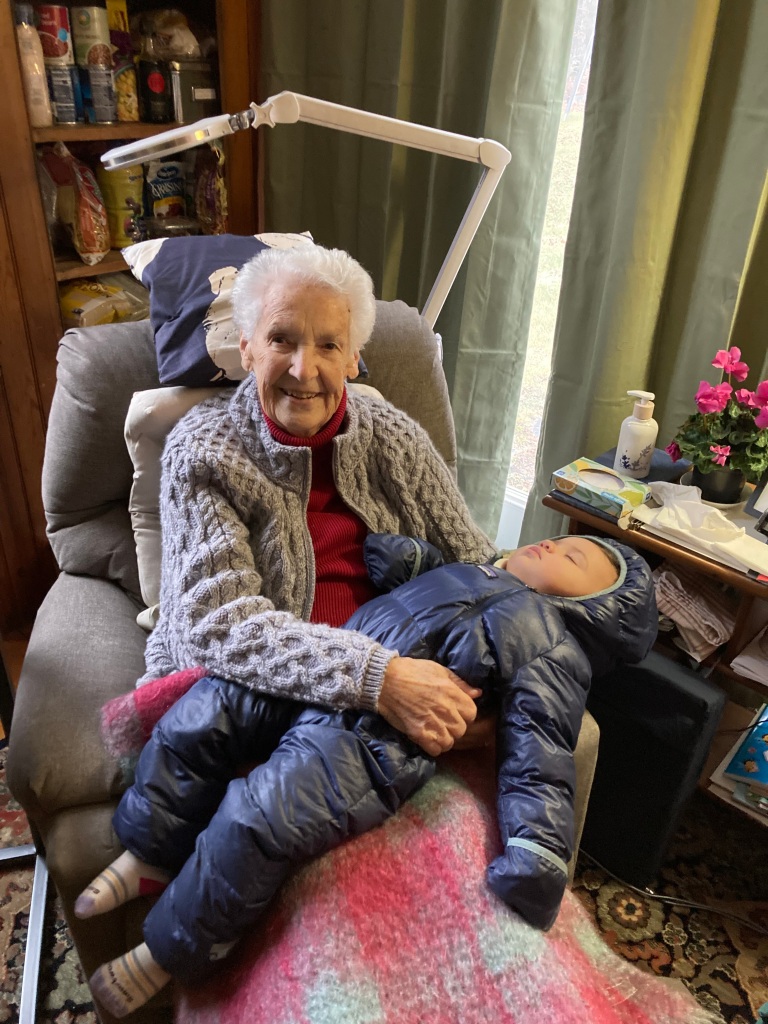
Photo courtesy of Mick Comstock
